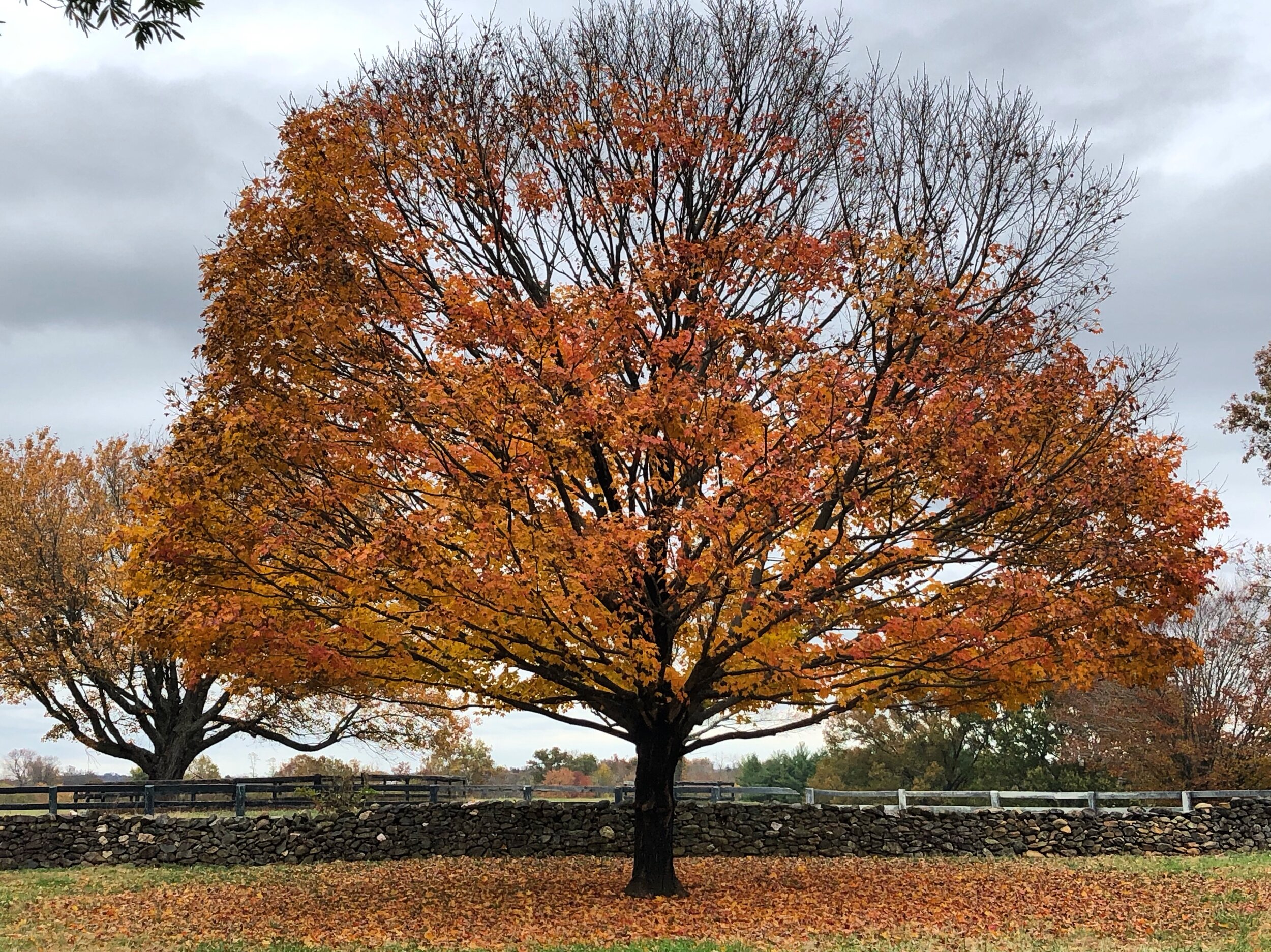Oak Spring Garden Foundation, Day 25
Regan Rosburg – Artist in Residence
I am standing at the table, looking down at my painting, when I heard the call of birds outside. My studio has a garage door that is completely open, and I sacrifice the chill of the late October air to hear the birds and see the view. Outside the open wall is a mile-long horizontal strip of runway, and beyond that is the slowly changing sculpture of deciduous trees in Virginia. I say sculpture because it exists as a marvelous, everchanging work of art that I have watched over the past month. As the cold comes and the days become shorter, each tree gathers her skyward skirts of colorful leaves, sucking in her sugars as if she is taking a deep breath. Golden yellows, rusty oranges, and sienna reds are all that is left of an entire summer of work. Each leaf has been tickled hundreds of times by insects and wind, and now gives way to one final gust of Fall air.
Downward it gracefully spirals, blowing kisses to its friends as they spin past. This is an ancient, glorious rite of passage.
As the leaves form a patchwork blanket of color below, the tree sinks her breath still deeper, storing her energy in the depths of the soil. None but mycelium, worms, beetles and moles will have the gracious fortune to curl up among her roots, where she safely keeps the promise of next Spring’s awakening in her net of underground darkness.
It is easy to think of trees and plants using only a frightfully dull and dangerous post-colonial mind. This mind appraises the tree as simply a donor of wood, paper, berries and fruit. One might think of them as convenient suppliers of shade, as ways to increase property value, and as the backdrop to our otherwise busy lives. One might think of trees as a source of heat and energy -- as logs in a fire, or as burnable biomass fuel that ensures our living room lights will come on. Although some of us are instinctively comforted by it, to other people the abstractness of the “natural world” morphs into a kind of stage set, and then carry on without noticing its true brilliance and intelligence.
As I stand at the table, I ponder each tree, as well as the group as a whole.
Each tree is a planet, a body, and a cell. Taken individually, each is a complex, living organism capable of learning. In the DNA of each tree are 3.8 billion years spent sipping on starlight. The starlight is converted into sugary starches, which then materialize in the plant’s structure (wood, roots, and leaves) or in the reproductive process (flowers, pollen, and potentially fruits). Taken as a whole, trees in a forest need each other. Studies have shown that when one tree gets ill or falls down, the rest of the forest will suffer. Though they compete for light, they are healthier together than they are alone, and thus a diverse forest is a thriving one. They live as families, maintaining millions of organisms upon their branches, between their layers of bark, within their thick carpet of fallen leaves, and in their roots spreading out beneath the ground.
The entire phenomenon of a tree is on a timeline that humans cannot comprehend. It requires the kind of patience and resilience that has been drained dry in a society focused on deadlines, return on investment, and exponential growth. The resilience of a tree means fortitude and hope as they weather storms and insects, witness neighboring trees being sawed into paper or are set on fire to make room for cattle. The resilience of a tree means to make it through a dry Summer, an especially cold Winter, and a drenching Spring. The resilience of a tree means to shade all of God’s creatures, even the ones who attack it with tiny teeth, beaks, and chainsaws.
Yet -- of all of the gifts given by these gorgeous, intelligent creatures, perhaps the most poetic of all is that which is invisible. Although we cannot hear it nor feel the minute trembling wind that must course past our fragile eyelashes at any given moment, trees are exhaling the oxygen we need to survive.
If one takes an even wider view, one can extend this appreciation further to all plants and animals on Earth. For most of the world’s population, our bodies are warm because we wear their hides and eat their flesh. Most of us live in their habitats yet treat their presence as a backdrop. Most of us survive on their milk, their oils, their fibers, their bones.
I think of this as I stand over my painting, looking at branches I have painted in black. I think of the birds that I hear in the trees, happily chattering to themselves FOR themselves, not for me.
So often I am on the verge of tears because of the piercing red light of sunrise, or a moment when a bird flew by and my subconscious recorded its wing beat… it goes on and on, thumping in my head, that gorgeous sound on repeat.
So often I see spiders struggle helplessly to get out of the kitchen sink and I think “if not for man, what branch would you be climbing on?”
So often I see tree branches and wonder what the feeling of a bird wrapping its claw around it must feel like.
I bet it is exhilarating.
Oak Spring Garden Foundation tree, during my 2019 Residency.
